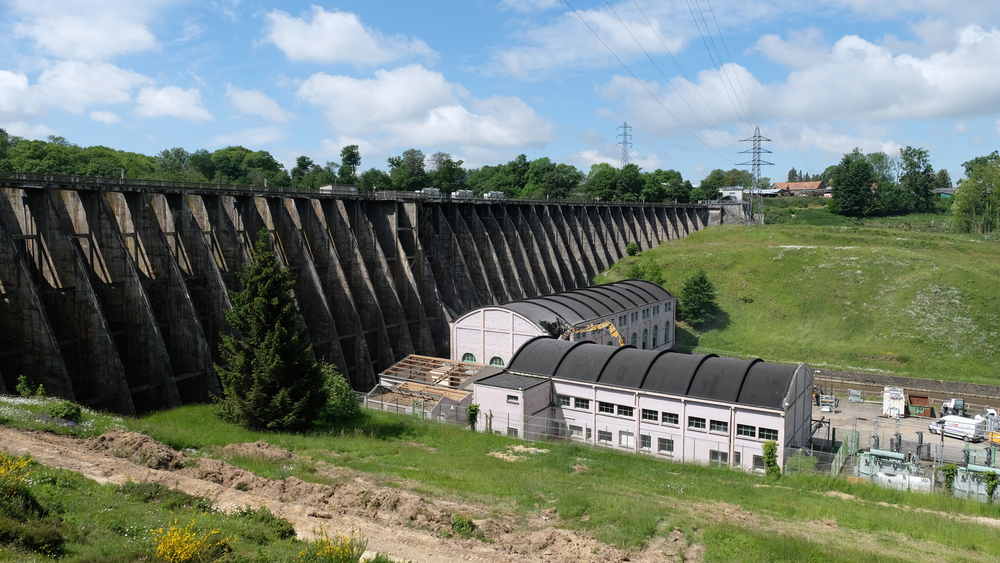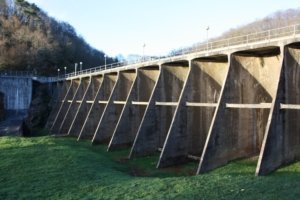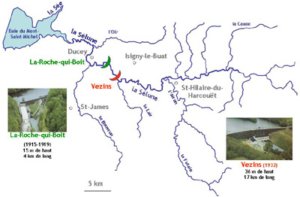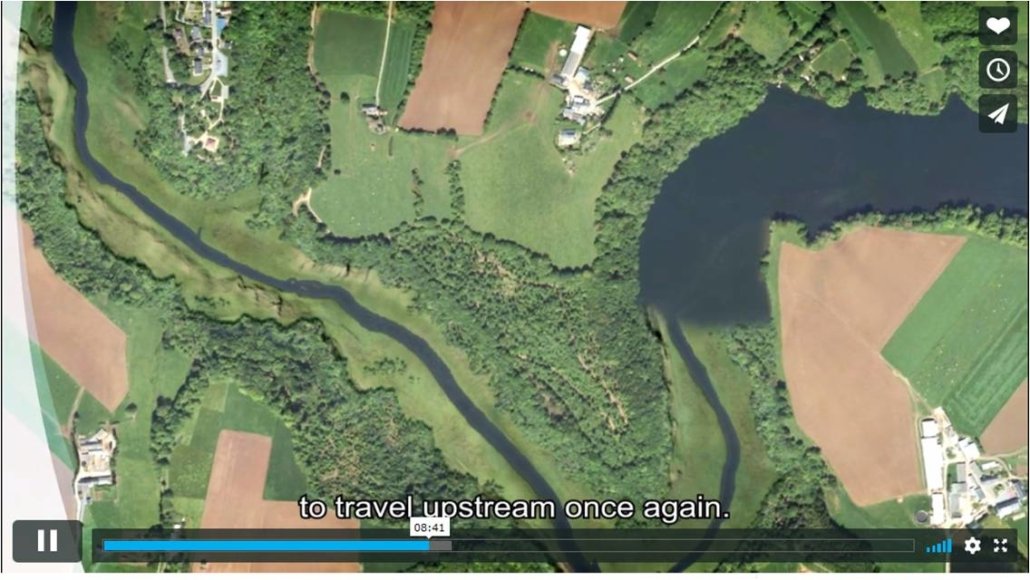Removal of two large dams (Vezins et Roche qui boit) to free the Sélune River !
Removal of two dams on the coastal river Sélune, Normandy, France
Vezins dam under deconstruction / CR : DDTM 50 / La-Roche-qui-Boit dam under deconstruction / CR: ERN, 2022
Abstract of the project (Updated May 17. 2024)
The hydroelectric dams of La Roche-qui-boit and Vezins were built on the Sélune between 1916 and 1932. At 16m and 36m high they constitute an unsurmountable hinderance for migratory fish that frequent this coastal river. Given the impacts, the regulatory obligations made previously to bring them up to standard, water quality problems they generate, their low energy productivity and reports which conclude it is technically impossible to rearrange them, removal the dams at the end of the concession period back in 2007 was requested by NGOs and also the represantatives of SAGE. Local opposition has also been strong. Summer 2019, the Vezins dam is being dismantled. The removal of the Roche-qui-boit dam began on 20 June 2022. The work was completed in spring 2023. Once the two large dams have been dismantled, almost 100 km of the river will be free for sediment and migratory fish. A major scientific monitoring programme has been accompanying this project since 2012 and will continue until 2027. The initial results of the post-dam removal monitoring carried out by INRAE are encouraging, with migratory fish (salmon, eel, lamprey) observed in the Sélune upstream of the former dams from the first year. A renaturation project to enhance and provide access to the Sélune valley is currently underway.
All decisions and highlights connected with removal of the Sélune dams
A project backed by scientific and technical considerations
As confirmed by the authority of res judicata and separate from the legal justification for removal, the Selune Valley renaturation project was necessary for both scientific and technical reasons. (See the chronology of the removal).
The reservoirs of Vezins and La Roche-Qui-Boit generate extremely large bodies of water taking away the natural character of close to 25 km of the Sélune River.
The Vezins lake is of poor ecological quality, while the Sélune river itself has been improving. This condition is further diminished by nutrient concentrations observed in the water, and the presence of chlorophyll which demonstrates eutrophication of the environment.
Swimming has been prohibited making the use of the lakes for nautical and aquatic activities impossible. The trophic and ecological imbalance linked to the poor water quality has lead to the development of cyanobacteria. These cyanobacteria can secrete toxins, some of which are extremely dangerous..
The Vezins reservoir causes significant sedimentation (the volume of sediments is currently estimated at around 2 million m3) and the management of stored volumes is problematic. Inhabitants still have in mind the disastrous emptying which took place in 1993. For the current project, the complexity of the works and the associated cost is directly related to sedimentary management, demonstrating the difficulties posed by the blockage of a transit that would be natural if Sélune was a free flowing river.
The reservoirs of Vezins and La Roche-Qui-Boit also hinder the natural process of self-purification which, if it could be freely exercised, contribute significantly to improved water quality.
The blockage of sediment flow associated with dams also results in the disappearance of substrates favorable to the life and reproduction of aquatic species.
The removal of the dams is necessary to
- Restore the hydrodynamic equilibrium of the Bay’s ecosystem. Indeed, after removal, the river will have recovered its hydrological and biological function and will result in much improved quality of both water and sediments.
- Ensure the return to the Sée-Sélune complex of an abundant population of Atlantic salmon, a population that according to the work of INRA and ONEMA, has a particularly important genetic and heritage relevance for this region of the Atlantic.
As of now, the potential of the Sélune Basin is estimated to be 5,000 Atlantic salmon. Of course, many migratory fish species will also benefit from this removal..
Ecological discontinuity of the dams and ministerial decision of their removal
Considered to be the 3rd best French river in terms of “Salmon potential”, the Sélune is a classified river for Atlantic salmon, sea trout, brown trout, European eel, pike, sea lamprey and river lamprey. In general, the waterways of the Sélune basin have a significant ecological potential and therefore benefit from a set of protection or classification measures (see chapter : Protection and classification measures of Sélune)
In addition to the adverse effects of these dams on the quality of the water in the reservoirs, their presence is a problem of ecological continuity, long since identified as the reason for associated protests.
As early as 2005 the “SAGE Sélune” has been positioning for removal of these dams in order to restore the Sélune migratory axis. And in 2009, based on a report by EDF in 2007, and the lack of technical possibilities to rearrange the dams to ensure fish and sediment continuity, the State decided not to renew the administrative titles of the Vezins and Roche-Qui-Boit dams and to begin the dismantling process. After several advances and retreat by the State, the removal of the Vezins and La-Roche-qui-Boit dams was definitively decided in 2017. (See the details of the steps that led to this decision).
Operational follow-ups and studies undertaken
Since 2009 and in order to give an operational follow-up to this decision, the Minister of State and the Secretary of State for Ecology have instructed the Prefect of the Departement la Manche to launch the operations required for the successful dismantling of the two dams and re-naturalization of the river.
Considering the clear desire to implement this project in terms of the environment and sustainable development, the State has launched numerous studies aimed at detailing technical choices. By defining the parameters such as re-naturalization, sediment management, waste management associated with decommissioning, fish management, etc. with the goal of achieving a zero state of the river, essential elements on which to assess the biological benefits, the works will take into account the effect of the removal on local activities and especially the impact on tourism on the surrounding villages.
The state has also been very concerned about the potential risks of the operation and has established:
- a flood risk study to analyze the current effect of the two dams on downstream flood flows.
- a study on the state of polluted sediments present on the site, including a characterization of the sediments and a site management plan
- a study of the release capacity of contaminants present in the sediments of the reservoirs
Since 2012 a scientific program has been conducted to monitor the dam removal operation. It is organized around four interrelated themes: Landscapes, Inhabitants, Uses, Ripisylve, Landscape, and Agriculture, Fluvial Dynamics and Aquatic Biocenosis (Resp J.-L Baglinière, Agrocampus Rennes). (See the complete program in English)
As part of the socio-geographical component of this program, a team of geographers and sociologists (Resp.M.A. Germaine, University of Paris West) are working on the transformations affecting the landscapes but also the uses and representations of the valley. This work proposes an inventory of fixtures, a history and a follow-up of the landscapes and uses of the valley of Sélune. The results of their research are available at: http://selune.hypotheses.org/ (Only available in French).
More info : SOISSONS, L., GERMAINE, M.-A., CHEVÉ, M., KREUTZENBERGER, K., BEAULATON, L., & ROUSSEL, J.-M. (2025). Genèse d’un suivi scientifique à long terme pour documenter les transitions écologiques et territoriales accompagnant l’effacement de grands barrages en France. Sciences Eaux & Territoires, (47), article 8330.
Localization
The Sélune is a coastal river which rises in Saint-Cyr-du-Bailleul in the department of Manche and which, after 91km flows into the bay of Mont Saint-Michel. The Roche-qui-Boit dam is 12km from the sea, which leaves another 70km of the Sélune river for migritory fish to deal with.
The Sélune hydropower plants
By prefectural decree of August 1914 and a further decree of the 23rd of November 1927, the Société des Forces Motrices de la Sélune (SFMS) was given authority to build and operate the La Roche-qui-Boit and Vezins dams for the production of hydroelectricity. The SFMS was nationalized in 1946, its assets then being transferred to Électricité de France (EDF).

© ERN France
Vezins dam
(built between 1929 et 1932)
– 17 km from the sea
– Concession period : 75 years (untill 31/12/2007)
– Power : 12,6 MW
– Production : 20 GWh
– Height : 36 mètres
– Width : 278 mètres
– Volume of the reservoir : 19 millions m3
– Length : 19 km
– Surface : 151 ha
La-Roche-qui-Boit dam
(built between 1916 et 1919)

© ERN France
– Located the most downstream, 12 km from the sea
– Power : 1,6MW
– Production : 4,7 GWh
– Height : 16 mètres
– Width : 129 mètres
– Volume of the reservoir : 1,4 millions m3
– Length : 4 km
– Surface : 40 ha
The production of these two EDF dams remains overall marginal. Indeed the needs of the Manche department are estimated at just over 2 billion kWh per year.






 ERN France
ERN France ERN is the official WWF Freshwater Partner in France and cooperates with WWF Switzerland, Austria, Netherlands and others
ERN is the official WWF Freshwater Partner in France and cooperates with WWF Switzerland, Austria, Netherlands and others